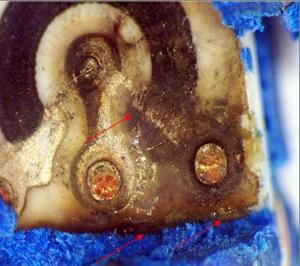Bourns RJR26 Potentiometer Failure
Gideon Analytical Labs performed failure Analysis on a failed RJR26 Bourns Potentiometer. The application failure was noticed when a lower than expected resistance value and, eventually, open in the potentiometer.
A potentiometer (or pot) is a simple electromechanical transducer. It converts rotary or linear motion from the operator into a change of resistance, and this change is used to control the resistance within a circuit. The pot (also known as a rheostat) is essentially a variable wire wound resistor or a carbon or metal film with a swiper. A potentiometer is an example of a voltage divider consisting of resistors in series. It is commonly used to create a reference voltage, or to get a low voltage signal proportional to the voltage to be measured, and may also be used as a signal attenuator at low frequencies. For direct current and relatively low frequencies, a voltage divider may be sufficiently accurate if made only of resistors.
These trimming potentiometers offer a standard resistance range between 10 and 1 megaohm, have a power rating of 300V maximum, and function within a temperature range between -65º C and 150º C. The terminals are solder pins.
Analysis revealed there was electromigration from the wiper to pin 1. This gave the lower than expected resistance when tested. Arrows in the picture above point to the problem: electromigration and residual water at the base of the package. Lower resistance was caused by the electromigration between pin 1 and the wiper. Electromigration does not occur unless a voltage and a transportation medium are present. The water found is more than adequate to accommodate this failure mode. Thus, ionics in the water caused the metal to migrate as the voltage was applied.
Failure analysis performed by Gideon Analytical Laboratories can pinpoint problems with electrical components and can help save electronic companies enormous amounts of time and money. Why let manufacturing flaws and components set your company back, call Gideon Analytical Laboratories to determine the cause of the problem.

Failed RJR26 Bourns Potentiometer